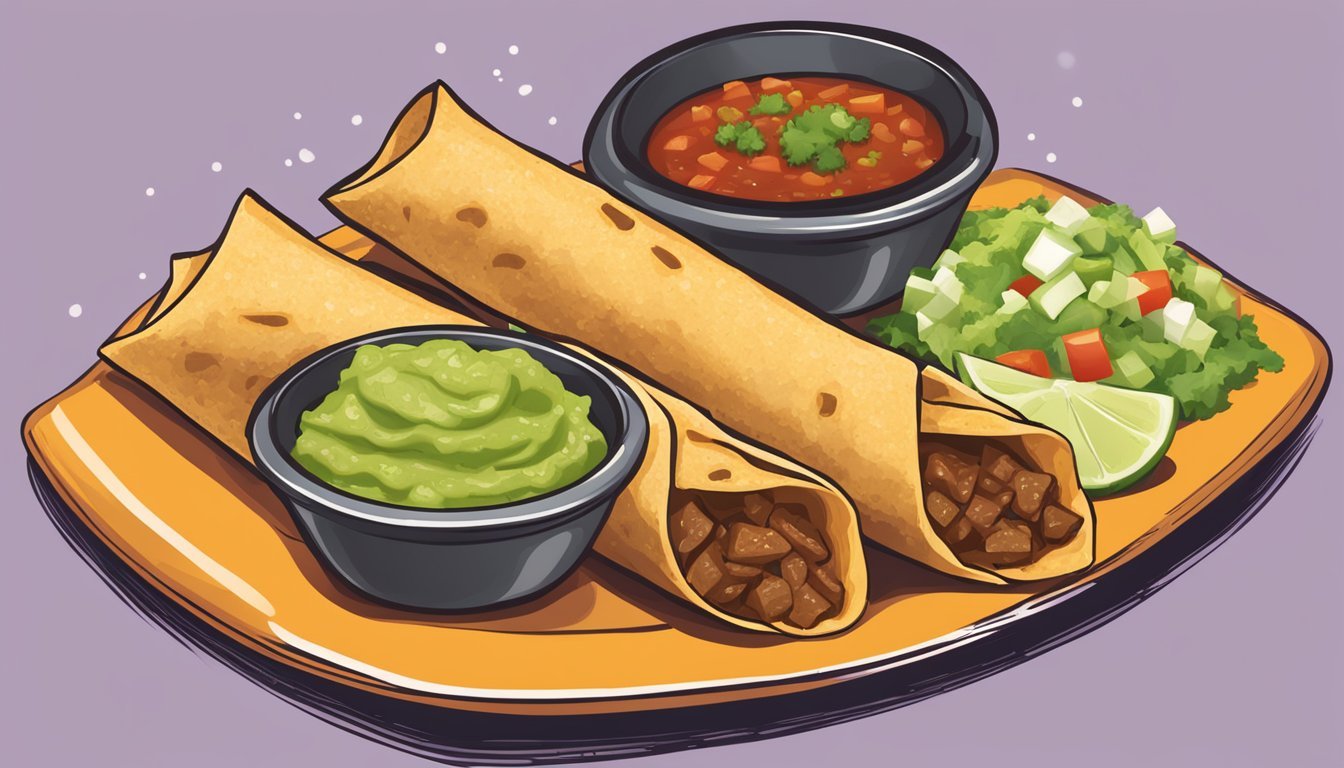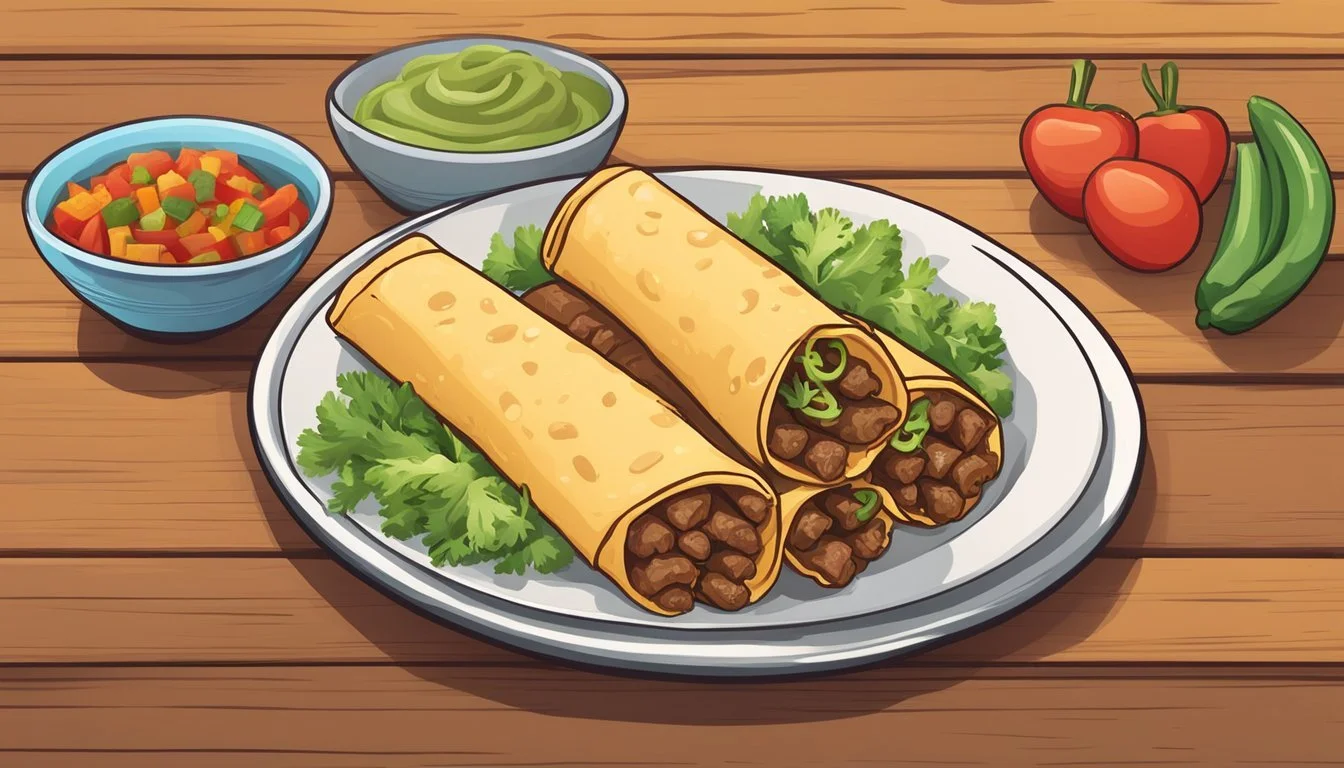How Long Do Beef Flautas Last?
Proper Storage and Shelf Life
Beef flautas are a beloved dish, enjoyed for their crispy texture and flavorful fillings. Properly stored, beef flautas can last in the refrigerator for up to 3-4 days, ensuring you enjoy their savory taste even after the initial serving. To maximize their shelf life, it's crucial to keep them in an airtight container to prevent moisture loss and maintain their crunch.
For those looking to extend the lifespan of their beef flautas even further, freezing is a viable option. When frozen, beef flautas can last up to 2-3 months. Ensure they are well-wrapped in aluminum foil or plastic wrap before placing them in a freezer-safe bag. This not only retains their flavor but also prevents freezer burn.
Understanding how to properly store and reheat beef flautas is essential for preserving their quality. Reheated flautas should regain their crispy exterior without becoming soggy, which can be achieved using an oven or air fryer. This guide offers practical steps to ensure your beef flautas remain delicious even after being stored.
Understanding Beef Flautas
Beef flautas are a popular Mexican dish comprised of shredded beef wrapped in tortillas and either fried or baked to perfection. This section explores the essence of beef flautas, their main components, the importance of the beef filling, and their nutritional profile.
Defining Flautas
Flautas, often referred to as taquitos in some regions, are a staple in Mexican cuisine. They consist of tortillas — either corn or flour — rolled tightly around a filling, typically meat such as beef, chicken, or pork. The rolled tortillas are then fried or baked until crispy. Flautas are usually garnished with toppings like shredded lettuce, cheese, sour cream, and salsa. This dish is known for its textural contrast, with a crunchy exterior and tender filling.
Components of Beef Flautas
The primary components of beef flautas include the beef filling, tortillas, and various seasonings.
Beef Filling: The meat is often cooked with spices such as cumin, garlic, and onion, then shredded.
Tortillas: Both corn and flour tortillas can be used. Corn tortillas offer a more traditional taste, while flour tortillas provide a softer texture.
Seasonings and Garnishes: Common seasonings include salt, pepper, and lime juice. Garnishes like sour cream, guacamole, and pico de gallo enhance the dish's flavor.
The Role of Beef in Flautas
Beef plays a crucial role in beef flautas.
The meat is typically slow-cooked until tender, then shredded to create a flavorful and moist filling. Cooking methods vary from boiling to slow roasting, often including ingredients such as garlic, onions, and chili peppers for added depth of flavor.
The shredded beef is then seasoned further and sometimes mixed with other ingredients like cheese before being rolled into the tortillas.
Nutrition Profile
The nutrition profile of beef flautas can vary based on ingredients and cooking methods.
Calories: A serving of beef flautas provides energy, usually ranging from 150 to 250 calories per flauta, depending on size and fillings.
Carbohydrates: The tortillas contribute a significant carbohydrate content, essential for energy.
Protein: Beef is a rich source of protein, contributing to muscle repair and growth.
Fats: There is a presence of saturated fats that come from both the beef and the frying method used.
Cholesterol and Sodium: These are present in moderate amounts due to the meat and seasonings.
Fiber and Sugar: These are typically low in flautas, though fiber can be upped by using corn tortillas and healthier fill options.
Understanding the key components and nutritional aspects of beef flautas can help individuals make informed choices about this delicious dish.
Preparation Techniques
Proper preparation is crucial for achieving delicious and long-lasting beef flautas. Detailed steps for assembling and cooking ensure that the flautas are both tasty and properly preserved.
Assembling Beef Flautas
Begin with tender, shredded beef prepared from your favorite recipe. Warm tortillas in foil in a 350° F oven for 10 minutes to make them pliable. Lay each tortilla flat and place a couple of tablespoons of shredded beef in the center. Optionally, add toppings like cheese or salsa to enhance flavor. Roll each tortilla tightly around the filling to form a cylinder. Secure the flautas with toothpicks at the seam to prevent them from unfolding during cooking. Maintaining even thickness along the roll ensures better cooking results.
Cooking Methods
Beef flautas can be cooked using several techniques, including frying, baking, or air frying. For frying, heat oil in a skillet or Dutch oven to 375°F. Fry the flautas in batches until golden and crisp, about 2-3 minutes per side.
For a healthier option, bake them in a 400°F oven. Place the flautas seam-side down on a baking sheet lined with cooking spray. Brush tops lightly with oil or spray to ensure a crisp finish. Bake for 20-25 minutes, flipping halfway through.
To air fry, preheat the air fryer to 375°F. Arrange the flautas in a single layer, ensuring they do not touch. Cook for 10-12 minutes, shaking the basket halfway. Each method ensures a crispy exterior and a flavorful interior.
Optimal Storage Conditions
Beef flautas remain safe and enjoyable to eat if stored under proper conditions. Adhering to correct refrigeration, freezing, and reheating practices ensures both the longevity and the quality of these delicious snacks.
Refrigeration
After cooking beef flautas, store them in the refrigerator at 40°F (4.4°C). To maintain freshness, it is recommended to place them in air-tight containers or tightly wrap them in foil. This prevents air exposure, reducing the risk of spoilage and bacterial growth. Consume refrigerated flautas within 3 to 4 days to retain optimal flavor and texture. Adding a light sprinkle of lime juice before storing can help keep the beef moist and flavorful.
Freezing
To extend the shelf life of beef flautas, freezing is an excellent option. Wrap each flauta individually in foil or plastic wrap, ensuring no air pockets remain, and then place them in a freezer-safe bag or container. Store flautas at 0°F (-17.8°C). For best quality, consume the frozen flautas within 2 to 3 months. Upon reheating, it is particularly important to use methods that preserve the texture, such as baking or air frying, to avoid sogginess caused by excess water or fat.
Reheating Recommendations
When reheating beef flautas, aim to restore their crispiness and warmth without compromising safety. If refrigerated, preheat the oven to 375°F (190°C) and bake for 10-15 minutes. For frozen flautas, thaw them in the refrigerator overnight and then bake at the same temperature. Using a light brushing of olive oil, canola oil, or vegetable oil before baking can help achieve a crispy exterior. Avoid microwave reheating, as it often results in uneven heating and a soggy texture.
Proper storage and handling not only ensure safety but also greatly enhance the eating experience of beef flautas, preserving their savory taste and satisfying crunch.
Shelf Life Determinants
The shelf life of beef flautas depends on various factors, including how they are prepared, stored, and the presence of any preservation techniques. Ensuring optimal conditions can help extend freshness and quality.
Factors Affecting Freshness
Several key factors can influence the freshness of beef flautas. Storage temperature is crucial; flautas should be kept refrigerated at or below 40°F (4.4°C) to slow bacterial growth. Ingredients, such as beef, cilantro, onions, and spices, also play a role. Fresh, high-quality components ensure better taste and longer shelf life.
Packaging methods are another determinant. Air-tight containers or vacuum-sealed bags reduce exposure to air, which can cause spoilage. Hygiene during preparation significantly affects freshness too. Clean hands, utensils, and working surfaces can minimize contamination.
Lastly, the inclusion of preservative ingredients such as lemon juice, with its Vitamin C content, can help inhibit spoilage. The natural acidity and antioxidants in lemon and certain spices, like garlic and pepper, add an extra layer of freshness.
Preservation Techniques
Effective preservation techniques can substantially extend the shelf life of beef flautas. Vacuum sealing is an excellent method to keep oxygen out, which helps prevent bacterial and mold growth. Flash freezing flautas immediately after preparation ensures that nutrients, such as calcium and potassium, are preserved while maintaining their texture and flavor.
Salting with kosher salt acts as a natural preservative by drawing moisture out, reducing bacterial growth. Use of herbs and spices like cilantro, garlic, and onions not only enhance flavor but also have mild preservative effects due to their natural antibacterial properties.
Proper refrigeration and freezing remain pivotal. Refrigerate the flautas for up to 3-5 days or freeze them for up to 3 months to maintain optimal quality. Using an organized labeling system with dates ensures flautas are consumed within safe periods.
Serving Suggestions
When serving beef flautas, adding the right accompaniments and presenting them attractively can enhance the dining experience. Consider the following accompaniments and presentation tips.
Accompaniments
Beef flautas pair wonderfully with a variety of fresh and savory side dishes. A dollop of sour cream and a sprinkle of cotija cheese or queso fresco add a creamy and tangy contrast to the flautas' crispy texture. Guacamole provides a rich, buttery element, while pico de gallo adds fresh, zesty flavors.
Salsa verde is a must for those who prefer a tangy and slightly spicy kick. Other ideal toppings include shredded lettuce, diced tomato, and cheddar cheese. For added freshness, garnish with chopped cilantro and a wedge of lime for squeezing.
Presentation Tips
To present beef flautas appealingly, start by arranging them neatly on a platter. Use rustic or brightly colored dishes to make the food pop. Place small bowls of guacamole, pico de gallo, and sour cream around the flautas for easy dipping. Garnish the platter with fresh cilantro and lime wedges to add vibrant color and a touch of elegance.
Rolling the flautas tightly ensures they hold their shape and look uniform. Secure them with toothpicks if needed, and cut them in half for easy handling and a striking visual. Serve hot and enjoy the crispiness at its best.
Common Questions
Understanding the proper storage times for beef flautas and the distinctions between similar dishes can help maintain their quality and taste. Additionally, knowing the best cooking methods ensures optimal results.
Difference Between Flautas and Taquitos
Flautas and taquitos are popular Mexican dishes, often confused due to their similarities. The primary difference lies in the type of tortilla used. Flautas typically use corn tortillas and are longer, while taquitos are generally made with flour tortillas.
Flautas are known for their golden brown appearance when fried. They often contain fillings such as shredded chicken or ground beef. Taquitos tend to be shorter and also feature various fillings, but the texture and flavor differ due to the tortilla type and cooking method.
Best Practices for Frying and Baking
Both frying and baking can yield delicious flautas, each with specific considerations.
For frying, use enough oil to submerge the flautas partially, heating it until it reaches 350°F. Cook them until they turn golden brown, typically around 2-3 minutes per side. This method achieves a crispy texture but can be oil-heavy.
Baking provides a healthier option. Preheat the oven to 375°F. Place the flautas on a parchment-lined baking sheet, seam-side down. Bake for approximately 20 minutes or until they become crispy and golden. To enhance even browning, lightly brush the flautas with oil before baking.
Health and Dietary Considerations
Beef flautas, while delicious, involve specific health and dietary considerations, especially when catering to various nutritional needs and allergen concerns.
Gluten-Free and Vegan Alternatives
For individuals with gluten intolerance or celiac disease, traditional flour tortillas used in flautas need replacement with gluten-free options. Corn tortillas are a suitable alternative as they are naturally gluten-free.
Vegan substitutions for beef in flautas can include plant-based proteins like tofu, tempeh, or jackfruit, which can mimic the texture of shredded beef. Season these alternatives well to maintain the flautas' flavor profile. Using vegetable oil instead of lard and opting for non-dairy cheese can further accommodate vegan dietary needs.
Allergen Information
Awareness of common allergens in beef flautas is essential. Ingredients often contain gluten, dairy, and sometimes soy. Checking the ingredient list for store-bought or restaurant flautas can help avoid these allergens.
Sodium content can be high, particularly in processed tortillas or seasoned beef, which is crucial for those on low-sodium diets. Preparing flautas at home allows for better control over sodium, cholesterol, and saturated fat content.
Ensuring proper cooking methods can also mitigate allergen risks and maintain nutritional balance.
Cultural Significance
Flautas, a beloved Mexican dish, have a rich cultural history and have made their mark in popular culture. The background and significance of this dish are deeply rooted in Mexican cuisine and its creative expression in media.
Mexican Cuisine History
Flautas, typically made with corn tortillas, represent a traditional Mexican dish with origins tracing back to indigenous culinary practices. Common ingredients include shredded beef, chicken, and spices like cumin and garlic, reflecting the vibrant flavors of Mexican cuisine. This dish showcases the cultural tradition of utilizing available ingredients creatively, such as fresh cilantro and other local herbs.
Historically, flautas are connected to family gatherings and street food culture in Mexico. Street vendors have popularized them as a quick and delicious snack. The role of corn tortillas in Mexican gastronomy is significant, symbolizing sustenance and tradition. As a result, flautas hold both culinary and cultural importance.
Flautas in Popular Culture
In modern times, flautas have transcended from traditional homes and street stalls to global platforms. Social media, particularly Instagram, plays a crucial role in their popularization. Culinary enthusiasts frequently share their flautas creations, highlighting various filling combinations and artistic presentations. This visual appeal amplifies the dish's popularity, making it a sought-after item in restaurants worldwide.
Additionally, restaurants and food trucks specializing in Mexican cuisine have adapted flautas to cater to diverse palates, offering unique twists and incorporating elements like fusion fillings. Flautas often appear in cooking shows and food blogs, further embedding them in popular culture. Their adaptability and flavorful profile ensure that they remain a beloved and iconic dish across cultures.
Recipe Variations
Beef flautas offer a versatile canvas that can accommodate a range of fillings, creative toppings, and sauces to enhance their flavor. The freedom to mix and match ingredients allows for endless culinary possibilities.
Alternative Fillings
Flautas can be filled with a variety of ingredients to suit different tastes and dietary preferences. Chicken is a popular choice; it can be shredded and mixed with diced onions, ground cumin, and chili powder for extra flavor.
For a vegetarian option, beans and chiles make an excellent filling. Refried beans combine well with sautéed peppers, such as diced jalapeños, to provide a rich, spicy taste.
Traditional fillings like beef chuck roast cooked with tomatillos and jalapenos offer a classic Mexican flavor. Additional options include using seasoned ground beef with beer for a unique twist, cooked with spices like ground cumin and chili powder.
Creative Toppings and Sauces
Toppings and sauces can elevate beef flautas from simple to spectacular. Mexican cream and crumbled cheese are traditional accompaniments that add richness and texture. Adding hot salsa offers a spicy kick, while a milder tomatillo sauce provides a tangy flavor.
Experiment with different salsas, such as a smoky chipotle salsa or a fresh pico de gallo with diced tomatoes, onions, and cilantro. Other creative toppings include guacamole, which adds creaminess, and pickled jalapeños for an extra burst of heat.
Dressing flautas with a drizzle of tangy lime crema or a smoky adobo sauce can also enhance their flavor profile, making them an inviting dish for any meal or occasion.
Conclusion
Beef flautas, when properly stored, can last in the refrigerator for 3 to 4 days. It is essential to place them in an airtight container to maintain their freshness.
If planning to store them longer, consider freezing. Beef flautas can be frozen for up to 2 months. To reheat, bake in the oven at 350°F until warm and crispy.
Always ensure that the flautas are reheated to an internal temperature of 165°F to ensure food safety. Proper storage not only keeps the flautas safe to eat but also maintains their quality.










